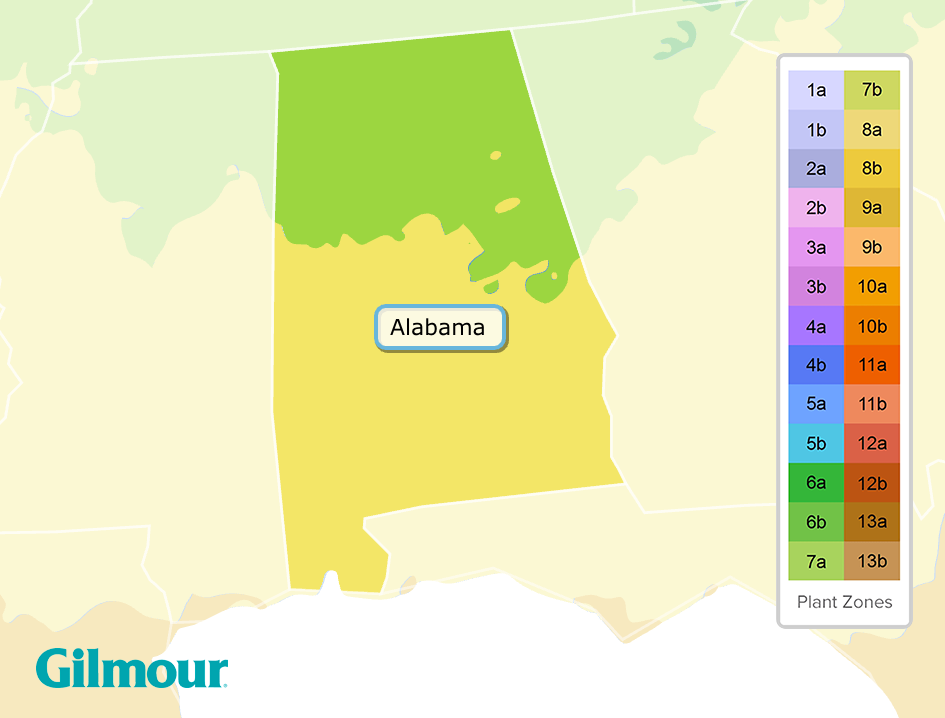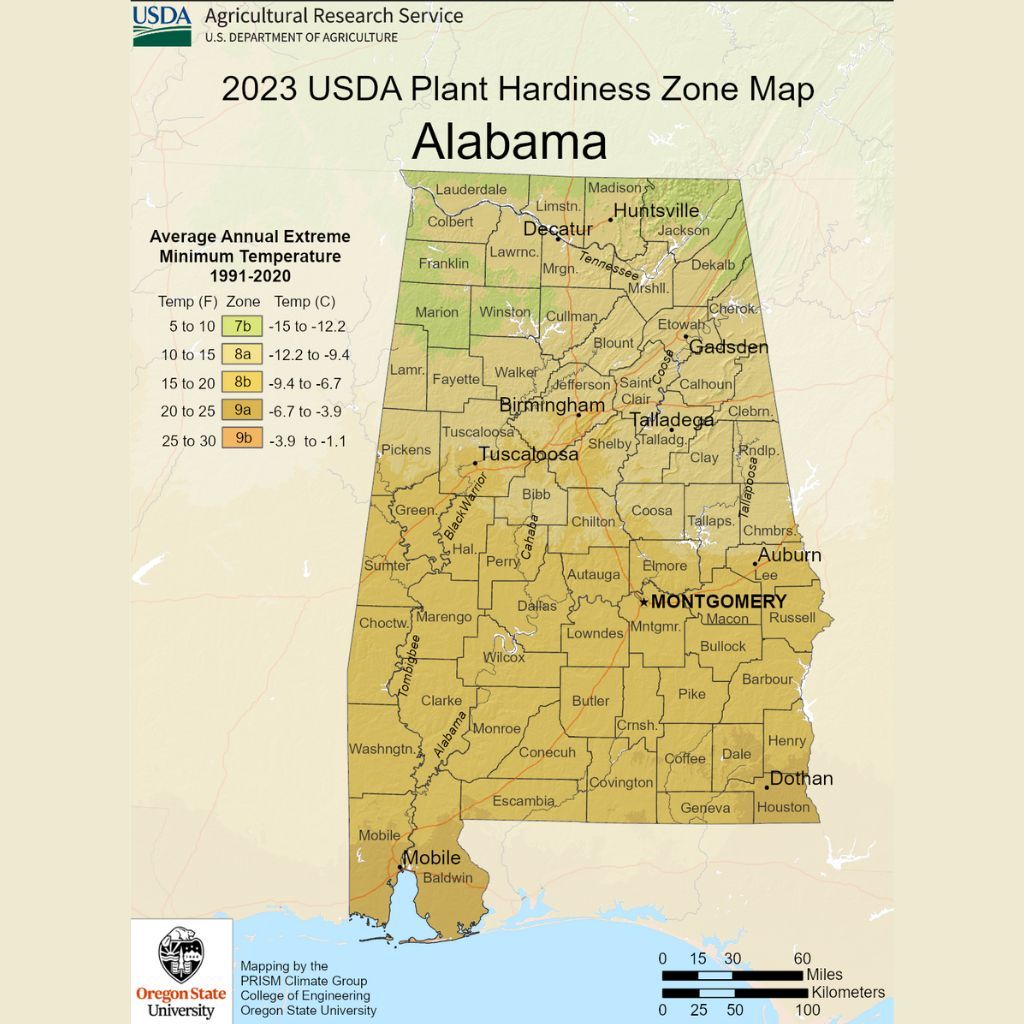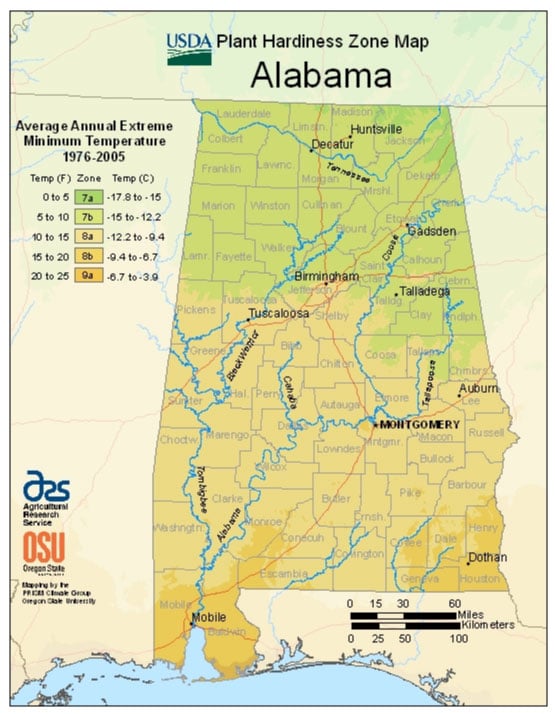Ever found yourself wondering, “What gardening zone is Alabama?” If you’re planning to plant a garden in the Heart of Dixie, you’re in the right place.
Understanding your gardening zone is like having a secret map to flourishing plants and bountiful harvests. It helps you know exactly what will thrive in your backyard. In Alabama, where the climate can vary from one region to another, knowing your specific gardening zone is crucial.
This knowledge can save you time, money, and most importantly, the heartbreak of seeing your plants struggle. So, if you’re curious about making your garden the envy of your neighborhood, keep reading. This guide will unlock the secrets of Alabama’s gardening zones and help you plant with confidence.
JUMP TO TOPIC
Gardening Zones Explained
Gardening zones help gardeners understand which plants thrive in specific regions. These zones are based on climate and temperature. Alabama’s gardening zone guides residents on what to plant. Knowing your zone ensures healthy growth and vibrant blooms. This knowledge is crucial for successful gardening.
Purpose Of Gardening Zones
Gardening zones map out regions based on their climate. They help determine which plants grow best in each area. These zones prevent planting mistakes and wasted resources. The USDA created these zones for gardeners and farmers. Each zone represents a range of temperatures. This helps in choosing plants that can survive local conditions.
How Zones Affect Plant Growth
Zones affect plant growth by indicating suitable climates. Different plants need specific temperature ranges. Zones tell you which plants match your local climate. This ensures plants receive the right conditions for growth. In Alabama, knowing the zone means healthier plants. It prevents damage from unsuitable temperatures. Choose plants that align with your zone for better results.

Credit: gilmour.com
Alabama’s Climate Characteristics
Understanding Alabama’s climate is essential for successful gardening. The state’s climate varies greatly, impacting plant growth and gardening results. Alabama spans several gardening zones due to its diverse climate characteristics. Knowing these can help gardeners choose the right plants and gardening strategies.
Temperature Ranges
Alabama experiences a range of temperatures throughout the year. Summers are typically hot, with temperatures often exceeding 90°F. Winters are mild, with average temperatures around 40°F. This range allows for a variety of plants to thrive. Gardens can flourish with heat-loving plants in summer and cool-season vegetables in winter.
Precipitation Patterns
Alabama receives abundant rainfall. Annual precipitation often exceeds 55 inches. Rainfall is spread throughout the year, supporting healthy plant growth. Spring and summer see the most rainfall, aiding in lush gardens. Fall and winter have less rain but still enough to sustain plants. Understanding these patterns helps in planning irrigation and drainage.
Identifying Alabama’s Gardening Zones
Identifying Alabama’s gardening zones helps gardeners choose the right plants. Alabama’s varied climate makes this crucial for successful gardening. Each zone has specific weather patterns affecting plant growth. Knowing these zones saves time and ensures plants thrive.
Usda Hardiness Zones
Alabama falls into USDA hardiness zones 7b to 8b. These zones determine plant survival based on winter temperatures. Zone 7b experiences temperatures as low as 5 to 10 degrees Fahrenheit. Zone 8b can have temperatures from 15 to 20 degrees Fahrenheit. These temperatures guide gardeners in selecting hardy plants.
Factors Affecting Zone Classification
Several factors influence Alabama’s zone classification. Elevation impacts temperature and frost. Higher areas experience colder temperatures. Coastal regions enjoy milder winters due to proximity to the ocean. Soil type also plays a role in plant growth and hardiness. Understanding these factors helps in choosing suitable plants for each area.

Credit: www.gardeningknowhow.com
Regional Variations Within Alabama
Alabama’s gardening zones offer diverse climates across the state. Understanding these regional variations can help gardeners make the best planting choices. The state has three main climatic regions, each with unique characteristics.
Northern Alabama Climate
Northern Alabama experiences colder winters and mild summers. This region falls under USDA Hardiness Zone 7. It is ideal for plants that tolerate cooler temperatures. Winters can bring frost, so choose hardy plants. Spring brings moderate rainfall, encouraging growth. Summer sees warmth without extreme heat.
Central Alabama Climate
Central Alabama enjoys a balanced climate. This area belongs to USDA Hardiness Zone 8. Winters are milder compared to the north. It supports a wide variety of plants. Central Alabama receives ample rainfall throughout the year. Summer temperatures can climb, demanding drought-tolerant plants. The growing season is longer, offering more planting options.
Southern Alabama Climate
Southern Alabama has a subtropical climate. This region is in USDA Hardiness Zone 9. Winters are mild and short. Summers are hot and humid, supporting tropical plants. Rainfall is abundant, benefiting moisture-loving species. Heat-tolerant plants thrive in these conditions. The long growing season allows for diverse cultivation.
Choosing Plants For Alabama
Gardening in Alabama offers an exciting opportunity to experiment with a variety of plants. The state’s diverse climate means you can cultivate a broad range of species. Whether you’re a seasoned gardener or just starting out, understanding what plants thrive in Alabama is essential for a flourishing garden.
Native Plants And Their Benefits
Native plants are an excellent choice for Alabama gardens. They have adapted to the local climate, making them hardy and easy to maintain. These plants often require less water and fertilizer, saving you both time and resources.
Consider the Alabama Blue Star or the Oakleaf Hydrangea. These plants enhance your garden’s beauty while attracting local wildlife. Imagine the sight of butterflies fluttering around your garden, adding a touch of natural wonder.
Choosing native plants also supports local ecosystems. By planting them, you contribute to the conservation of Alabama’s unique biodiversity. Your garden becomes a haven for native species, fostering a balanced environment.
Popular Garden Choices
Besides native plants, Alabama gardeners love vibrant flowers and robust vegetables. Azaleas are a popular choice for their striking colors and ability to thrive in the state’s climate.
If you enjoy fresh produce, consider growing tomatoes, peppers, and okra. These vegetables flourish in Alabama’s warm temperatures and can be a delicious addition to your meals.
Think about how rewarding it would be to step into your garden, pick a ripe tomato, and use it in a homemade salad. Gardening can be a delightful culinary adventure.
As you plan your garden, reflect on what you want to achieve. Are you looking to create a space full of life and color, or are you aiming for a productive vegetable patch? Your choices can bring joy and satisfaction, transforming your outdoor space into a personal oasis.
Tips For Successful Gardening
Gardening in Alabama offers unique opportunities and challenges. The state’s climate varies, but its gardening zone primarily falls within zones 7a to 8b. This means mild winters and long growing seasons. To thrive in these zones, gardeners must adopt certain practices. Below are tips for successful gardening in Alabama’s unique climate.
Soil Preparation And Maintenance
Alabama’s soil ranges from clay to sandy. Test your soil before planting. This helps you know its pH and nutrient levels. Amend the soil with organic matter. Compost and well-rotted manure improve soil structure. They enhance drainage and nutrient content. Regularly till the soil to prevent compaction. Aerated soil promotes root growth. Mulching helps retain soil moisture. It also suppresses weeds.
Watering And Fertilization Techniques
Water deeply and infrequently to encourage deep roots. Early morning is the best time to water. This reduces evaporation and fungal diseases. Use soaker hoses or drip irrigation to conserve water. Fertilize your plants based on their specific needs. Over-fertilization can harm plants and the environment. Use slow-release fertilizers for steady nutrient supply. Organic fertilizers, like compost tea, are excellent choices. They enrich the soil naturally and improve plant health.
Climate Change And Gardening Zones
Climate change is reshaping gardening zones across the globe. These zones determine which plants thrive in different regions. In Alabama, the impact of climate change is evident. Shifts in temperature and rainfall patterns are influencing gardening practices. Understanding these changes helps gardeners adapt effectively.
Potential Shifts In Zones
Alabama’s gardening zones might see shifts due to climate change. Warmer temperatures can push zones northwards. This means plants from warmer areas might suit Alabama soon. Shifts in zones could affect plant survival rates. Gardeners need to stay updated on these changes. Monitoring the latest zone maps can be beneficial.
Adapting Gardening Practices
Adaptation is key for successful gardening in changing zones. Choosing plants suited to new conditions ensures healthy growth. Consider drought-resistant varieties as rainfall patterns change. Shading techniques can protect plants from increased heat. Mulching helps retain soil moisture during dry spells. Using native plants might offer better resilience.

Credit: www.ufseeds.com
Frequently Asked Questions
What Is Alabama’s Gardening Zone?
Alabama is primarily in USDA hardiness zones 7b to 8b. These zones indicate the average lowest winter temperatures. They help gardeners choose plants that will thrive in their region. Zone 7b covers the northern parts, while zones 8a and 8b cover the central and southern regions.
How Do Gardening Zones Affect Planting?
Gardening zones guide gardeners on plant selection and timing. They indicate the area’s climate conditions. This helps in choosing plants that can survive local temperatures. Planting at the right time ensures better growth and yield. It’s crucial for both ornamental and edible plants.
Can I Plant Tropical Plants In Alabama?
Yes, you can plant tropical plants in Alabama. Zones 8a and 8b support many tropical species. However, during colder months, some plants may need protection. Consider using mulch or frost blankets. Ensure they have proper water and sunlight to thrive.
When Should I Start Planting In Alabama?
Start planting in Alabama after the last frost date. In northern Alabama, this is usually late March. In southern regions, you can start in early March. Knowing your zone helps determine the best planting time. Early planting ensures a longer growing season.
Conclusion
Understanding Alabama’s gardening zones helps plan your garden effectively. Each zone offers unique planting opportunities. Knowing your zone ensures better plant growth. Alabama’s zones range from 7a to 9a. These variations affect planting times and plant choices. Choose plants suited for your zone for success.
This knowledge guides gardeners in planting decisions. It also helps prevent common gardening mistakes. Happy gardening in Alabama’s diverse climate! Enjoy nurturing your plants with confidence. Your garden will thrive with the right choices. Keep exploring and learning about your zone.
Gardening brings joy and satisfaction.
